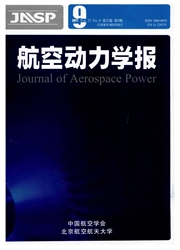

 中文摘要:
中文摘要:
针对简化的叶片尾缘,设计了3种旋流冷却结构,即冷气分别从旋流腔中部射流孔、旋流腔异侧射流孔、旋流腔同侧射流孔进出旋流腔,并与常规凸台扰流柱冷却结构进行了对比数值研究,分析其强化换热机理和效果.结果表明:旋流腔的结构和冷气的进流布置对旋流冷却性能的影响很大,冷气从旋流腔某侧射流孔进出的旋流冷却结构不仅在流向截面产生涡旋,在展向截面也会产生涡旋,从而有效强化对流换热;相比凸台扰流柱冷却结构,旋流冷却结构能够增强换热,平均努塞尔数增大6.8%~22.9%,但流动阻力也随之增加;冷气从旋流腔异侧射流孔进出的冷却结构强化换热能力较高;而冷气从旋流腔同侧射流孔进出的冷却结构流动换热综合系数比凸台扰流柱提高4.2%,综合性能相对较优.
 英文摘要:
英文摘要:
Three different kinds of vortex cooling configurations were designed and applied to the simplified blade trailing edge. The cooling air flow was injected into the vortex cavities from jet orifices located at the middle of the vortex cavity, staggered side of the vortex cavity and the inline side of the vortex cavity, respectively. A comparison with the common cooling channel fitted with bumps and pin fins was made by numerical simulation. The mechanism and effect of enhanced heat transfer were analyzed. Results show that the configuration of vortex flow cavity and the arrangement of cooling air inflow have important influences on the vortex cooling performances. The vortex cooling configurations with the cooling air injected to one side of the vortex cavity causes significant vortex flows not only in the streamwise plane but also in the spanwise plane, which enhances the convection heat transfer. The vortex cooling configuration can enhance heat transfer in comparison with the bumps and pin fins, with the average Nusseh number increasing 6.8%--22.9%. However, the flow resistance also increases. The vortex cooling configuration with the jet orifices located at the staggered side of the vortex cavity enhances heat transfer capacity greatly, and the configuration with the jet orifices located at the inline side of the vortex cavity, of which the comprehensive coefficient of convection heat transfer is 4.2% higher than that of the bumps and pin fins, achieves the best comprehensive performance.
 同期刊论文项目
同期刊论文项目
 同项目期刊论文
同项目期刊论文
 Convective heat transfer on a flat plate subjected to normally synthetic jet and horizontally forced
Convective heat transfer on a flat plate subjected to normally synthetic jet and horizontally forced Numerical investigation of convective heat transfer on a vertical surface due to resonating cantilev
Numerical investigation of convective heat transfer on a vertical surface due to resonating cantilev 期刊信息
期刊信息
